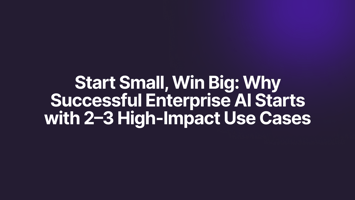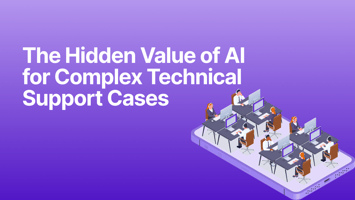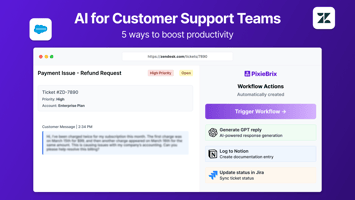Trying to AI-enable everything at once is a recipe for stalled progress. Learn how focusing on a...
AI Transformation in Finance 2025: 5 Key Trends to Watch

The finance industry in 2025 is being redefined by AI – from combating fraud in real-time to tailoring every customer interaction. Here’s a deep dive into five game-changing trends, along with insights from top AI leaders driving this revolution.
🔒 AI-Driven Fraud Detection & Cybersecurity
Banks are leveraging AI to fight financial crime and cyber threats faster and smarter than ever. AI systems monitor transactions in real-time, flagging anomalies within seconds to thwart fraud attempts. This tech-driven vigilance is critical as data breaches cost companies $4.88M on average, and 60% of finance firms plan to adopt AI for fraud prevention in the next 18 months. The payoff? Fewer fraudulent losses, quicker incident response, and more secure banking environments.
Key takeaway: AI has become the financial sector’s new cybersecurity watchdog, making fraud prevention proactive instead of reactive.
🤖 Personalized Services & AI-Powered Customer Engagement
Hyper-personalization is the new competitive battleground in banking. Generative AI and machine learning enable banks to analyze customer data and behavior deeply, then deliver financial advice and product recommendations tailored to each individual. In fact, McKinsey estimates that AI-driven personalization could add $340 billion annually to the banking sector. We’re seeing 24/7 AI assistants and chatbots elevate customer service – for example, BBVA’s “Blue” assistant offers 120+ banking functions, from checking balances to reporting lost cards, improving convenience and satisfaction. By anticipating needs and engaging with empathy, banks strengthen loyalty. Actionable insight: Leverage AI to know your customers and meet them where they are – today’s consumers expect financial partners that understand their goals in real time.
📊 AI-Powered Risk Assessment, Investment Strategies & Credit Scoring
AI is transforming how financial institutions assess risk and make investment decisions. In lending, machine learning models now evaluate creditworthiness using alternative data (like employment history or utility payments), bringing more people into the financial system who lack traditional credit history. This means fairer credit scoring and broader access to loans, with AI-driven underwriting engines boosting accuracy – L&T Finance’s “Project Cyclops” is one example, using AI to improve credit assessment efficiency. In markets, algorithmic trading algorithms driven by AI analyze massive datasets (market trends, news sentiment, social media) and execute trades in split-seconds, optimizing portfolios with precision. Even investment management is benefiting: AI tools provide real-time portfolio risk analysis and tailored wealth advice, a capability that used to require teams of analysts. Notably, firms like Equifax report that 85% of their new risk models are now built using AI/ML techniques – a huge shift toward data-driven decisioning.
Thought leadership angle: AI isn’t just crunching numbers; it’s augmenting human expertise in risk management, enabling more inclusive, data-informed financial strategies.
🏭 Generative AI in Banking Operations & Automation
2025 is witnessing the rise of generative AI as a co-pilot in banking operations. Banks are deploying advanced AI (like GPT-style models) to automate and enhance internal workflows. For instance, Citigroup used generative AI to review and summarize 1,000+ pages of new regulatory rules, helping compliance teams react faster to complex changes. Morgan Stanley equipped 16,000 financial advisors with an AI assistant tapping a knowledge base of 100,000+ research reports – giving them instant answers and insights for clients. Even routine tasks are being streamlined: some banks report AI chatbots for employees boosted internal process efficiency by 50%, handling everything from document drafting to call transcriptions. This automation doesn’t replace workforce talent; it augments it – freeing up employees from drudge work to focus on higher-value analysis and customer interaction.
Key takeaway: Generative AI is becoming the unseen “team member” in banks’ back offices – accelerating workflows, improving accuracy, and cutting costs.
⚖️ Ethical AI, Compliance & Regulatory Challenges
With great power comes great responsibility. As AI permeates finance, ethical AI and compliance have become non-negotiable priorities. Banks face strict scrutiny to prevent algorithmic bias and ensure AI-driven decisions are fair and transparent. A key focus is avoiding unintentional discrimination in models (e.g., in credit lending) by using comprehensive, diverse datasets. Regulators and industry standards are evolving fast – firms must adhere to data privacy laws, ensure explainability in automated decisions, and maintain robust oversight of AI systems. Forward-looking banks are investing in ethical AI frameworks and governance teams to audit algorithms and uphold consumer protection guidelines. Notably, AI leaders stress the importance of these efforts: Bob De Caux (Chief AI Officer, IFS), for example, advocates for transparency in data use and explainable AI decisions, aligning AI development with legal frameworks to keep systems accountable. In practice, this means building AI that stakeholders can trust – models that are not only effective, but also fair, secure, and compliant by design.
Actionable insight: Make “responsible AI” a core part of your strategy. Banks that balance innovation with ethics will win customer trust and regulatory confidence.
🏅 Spotlight: Insights from Top AI Officers of 2025
The wave of AI innovation in finance is being steered by visionary leaders. Here are a few industry trailblazers from the “Top AI Officers of 2025” list and how they are driving AI adoption in finance:
- Bhavesh Dayalji (Chief AI Officer, S&P Global)
Under Dayalji's leadership, S&P Global has introduced several AI-driven initiatives. Notably, the company launched generative AI-powered enhancements to its S&P Capital IQ Pro platform, including Document Intelligence and ChatIQ. These tools utilize advanced AI to streamline document analysis and assist users in their research. Dayalji highlighted the significance of these developments, stating, "ChatIQ is one example of how S&P Global is developing and deploying AI to add value for our customers."
- Dr. Debarag Banerjee (Chief AI & Data Officer, L&T Finance)
As the leader of a growing team of 130+ AI, ML, Dats Science, Analytics, and Data Engineers, Dr. Banerjee has been an integral part in growing L&T's diverse portfolio of B2C lending products. In 2024, Dr. Banerjee announced "Project Cyclops," an AI-powered credit underwriting engine developed by L&T Finance to enhance the accuracy and efficiency of credit assessments.
- Deep Ratna Srivastav (Chief AI Officer, Franklin Templeton)
Srivastav has emphasized a multi-layer intelligence approach, synchronizing various AI capabilities to deliver advanced insights and services. He views AI not as a singular capability but as a suite of tools driving transformative change across multiple business dimensions, from creating demand for new products to improving operational efficiencies and client interactions.
- Dr. Yannick Lallement (VP & Chief AI Officer, Scotiabank)
Under his guidance, Scotiabank has adopted cutting-edge solutions, including generative AI tools like Microsoft’s M365 Copilot, to optimize productivity and redefine the future of work. Dr. Lallement highlights that GenAI is transforming business, particularly in terms of process improvement, to streamline routine or labour-intensive text or data summarization tasks.
💡 Food for Thought: These leaders illustrate that successful AI adoption in finance requires more than technology – it demands vision, cross-functional collaboration, and a commitment to ethical, customer-centric innovation. As AI continues to evolve, finance professionals must stay curious and proactive.


